Distribution Patterns and Genesis of Geological Fractures/Microfaults in the Qiongdongnan Basin, North of the South China Sea
Abstract
:1. Introduction
2. Geological Setting
3. Data and Methods
4. Spatial Distribution of Geological Fractures
4.1. Definitions of Fractures/Microfaults of Different Patterns in Seismic Sections
4.2. Observation and Description of Fractures in the Seismic Section
4.2.1. Bed-Bounded Fractures/Microfaults
4.2.2. Unbounded Fractures/Faults
4.2.3. Fracture Bunch
4.2.4. Fracture Cluster
4.3. Spatial Distribution of Fractures
- (1)
- It can be observed that a large number of fractures are dispersed throughout the stratigraphic space of the research area, which differs from the observations of the seismic section. Figure 8a presents the distribution of spatial fractures above the horizontal slice, while Figure 8b presents the distribution of spatial fractures below the horizontal slice. The number of fractures is significantly higher below the horizontal slice, and the size of the fractures diminishes in the vertical direction. Laterally, the fractures within the delineated BSR area are much more developed than those far from the BSR. Therefore, the fracture system and BSR constitute a good coupling relationship.
- (2)
- Observations of the distribution structure of fractures below the BSR (or slice) show that the fractures are well dispersed (DSPD) but also exhibit local concentration (CCTD). Among the dispersed fractures, the number of fractures observed across the BSR/slice is exceedingly small; hence, the dispersed fractures appear independent or few and are challenging to observe in this interval. However, the dispersal form of the fractures is far more widespread than that above the BSR/slice (Figure 8b). As stated above, two fracture clusters are observed in this area, and most fractures have stub or cone-shaped fracture outlines. Furthermore, the dense fracture assemblage in the deeper formation space gradually decreases upward, eventually forming many bunched fracture assemblages that cut through the BSR/slice (Figure 8b).
- (3)
5. Discussion
5.1. Possible Geneses of Different Kinds of Fractures
- (1)
- Bed-bounded fractures
- (2)
- Unbounded fractures
- (3)
- Fracture bunches
- (4)
- Fracture clusters
5.2. Relationship between the BSR and Fracture System and Its Implications for Fluid Transport
6. Conclusions
- (1)
- Compared with observing the field outcrop and core drilling, observing seismic images and the hollowed out coherent volume is more convenient when aiming to analyze the detailed fracture distribution structure in deep-water basins.
- (2)
- Based on the distribution patterns in the seismic images of fractures and the intersectional relationships between fractures and strata, four types of fractures were identified: bed-bounded fractures/microfaults, unbounded fractures, fracture bunches, and fracture clusters. These types of fractures represent the most important existing forms of fractures in sedimentary basins.
- (3)
- Bed-bounded fractures/microfaults are mainly short, have high density, and develop in MTDs of ultra-shallow layer or Meishan and Sanya formations. Unbounded fractures/microfaults are mainly long, discrete, and occur in Miocene–Pliocene formations; they also connect hydrocarbon source rock with reservoirs. Fracture bunches and fracture clusters commonly develop with the accumulation of large numbers of fractures, and occur in Oligocene–Early Miocene formations.
- (4)
- The differences in scale (length, density, etc.), development intervals, and combination form of the various types of fractures are closely related to their respective geological origin. Bed-bounded fractures/microfaults and polygonal faults are formed via drainage mechanisms and dehydration shrinkage in the MTDs. Unbounded fractures are mainly caused by strong tectonic movements, differential subsidence, and sustained overpressure. The release of gas chimney pressure in the diapir top overpressure–normal transition zone tends to form fracture bunches. These fracture clusters may be related to diapirs and transverse bending and folding over basement fault blocks.
- (5)
- In the 3D space view, the fractures above the anomaly are substantially less numerous than those below it. This pattern generates an acceptable supply of fluid/gas with limited dispersion during the hydrate accumulation process, making this pattern a generally suitable indicator of hydrate deposits and valuable when checking for fluid/gas leakage.
- (6)
- The pattern of fracture development can be used to evaluate the capacity for heterogeneous fluid flow. According to the spatial distribution and seismic reflection characteristics of fractures, there are at least six main routes for the transmission and accumulation of fluid/gas; these involve assemblages of fractures, thin sand layers, and hydrate reservoirs. They can effectively connect hydrocarbon sources to hydrate reservoirs in shallow layers, thus rendering them beneficial to the accumulation of fluid/gas. This model can explain the migration and accumulation characteristics of deeply sourced pyrolysis gas, as well as the vertical charging mode of medium and shallow biogenic gas reservoirs.
Author Contributions
Funding
Data Availability Statement
Acknowledgments
Conflicts of Interest
References
- Guliev, I.S. A Review of Mud Volcanism; Azerbaijan Academy of Sciences Institute of Geology: Baku, Azerbaijan, 1992; p. 65. [Google Scholar]
- Graue, K. Mud volcanoes in deep-water Nigeria. Mar. Pet. Geol. 2000, 17, 959–974. [Google Scholar] [CrossRef]
- Baristeas, C.; Anka, Z.; Primio, R.; Rodriguez, J.F.; Marchal, D.; Dominguez, F. Distribution of hydrocarbon leakage indicators in the Malvinas Basin, offshore Argentine continental margin. Mar. Geol. 2012, 332–334, 56–74. [Google Scholar] [CrossRef]
- Brown, A. Evaluation of possible gas microseepage mechanisms. AAPG Bull. 2000, 84, 1775–1789. [Google Scholar]
- Riedel, M.; Collett, T.S.; Kumar, P.; Sathe, A.V.; Cook, A. Seismic imaging of a fractured gas hydrate system in the Krishna–Godavari Basin offshore India. Mar. Pet. Geol. 2010, 27, 1476–1493. [Google Scholar] [CrossRef]
- Yoo, D.G.; Kang, N.K.; Bo, Y.Y.; Kim, G.Y.; Ryu, B.J.; Lee, K.; Riedel, M. Occurrence and seismic characteristics of gas hydrate in the Ulleung Basin, East Sea. Mar. Pet. Geol. 2013, 47, 236–247. [Google Scholar] [CrossRef]
- Zhang, Z.; Wright, C.S. Quantitative interpretations and assessments of a fractured gas hydrate reservoir using three-dimensional seismic and LWD data in Kutei basin, East Kalimantan, offshore Indonesia. Mar. Pet. Geol. 2017, 84, 257–273. [Google Scholar] [CrossRef]
- Cook, A.E.; Goldberg, D.; Kleinberg, R. Fracture-controlled gas hydrate systems in the northern Gulf of Mexico. Mar. Pet. Geol. 2008, 25, 932–941. [Google Scholar] [CrossRef]
- Liang, J.Q.; Zhang, W.; Lu, J.A.; Wei, J.G.; Kuang, Z.G.; He, Y.L.; GMGS5 Expedition. Geological occurrence and accumulation mechanism of natural gas hydrates in the eastern Qiongdongnan Basin of the South China Sea: Insights from site GMGS5-W9-2018. Mar. Geol. 2019, 418, 106402. [Google Scholar] [CrossRef]
- Bai, Y.; Yang, J.; Sun, J.; Shang, X.; Han, J. Self-filling and plugging performance of a thixotropic polymer gel for lost circulation control in fractured formation. Geoenergy Sci. Eng. 2023, 225, 211717. [Google Scholar] [CrossRef]
- Martel, S.J.; Pollard, D.D. Mechanics of slip and fracture along small faults and simple strike-slip fault zones in granitic rock. J. Geophys. Res. 1989, 94, 9417–9428. [Google Scholar] [CrossRef]
- Feng, S.; Wang, H.; Cui, Y.; Ye, Y.; Liu, Y.; Li, X.; Wang, H.; Yang, R. Fractal discrete fracture network model for the analysis of radon migration in fractured media. Comput. Geotec. 2020, 128, 103810. [Google Scholar] [CrossRef]
- Hooker, J.N.; Laubach, S.E.; Marrett, R. Fracture-aperture sizedfrequency, spatial distribution, and growth processes in strata-bounded and non-strata-bounded fractures, Cambrian Mesón Group, NW Argentina. J. Struct. Geol. 2013, 54, 54–71. [Google Scholar] [CrossRef]
- Narr, W. Fracture density in the deep subsurface: Techniques with application to point arguello oil field. AAPG Bull. 1991, 75, 1300–1323. [Google Scholar]
- Zeng, L.; Liu, H. Influence of fractures on the development of low-permeability sandstone reservoirs: A case study from the Taizhao district, Daqing Oilfield, China. J. Pet. Sci. Eng. 2010, 72, 120–127. [Google Scholar] [CrossRef]
- Fletcher, D.; Goss, E. Forecasting with neural networks: An application using bankruptcy data. Inf. Manag. 1993, 24, 159–167. [Google Scholar] [CrossRef]
- Ligtenberg, H.; Connolly, D. Chimney detection and interpretation, revealing sealing quality of faults, geohazards, charge of and leakage from reservoirs. J. Geochem. Explor. 2003, 78–79, 385–387. [Google Scholar] [CrossRef]
- Sibson, R. A Brief Description of Natural Neighbor Interpolation. In Interpolating Multivariate Data; John Wiley & Sons: New York, NY, USA, 1981; pp. 21–36. [Google Scholar]
- Bour, O.; Davy, P.; Darcel, C.; Odling, N.E. A statistical scaling model for fracture network geometry, with validation on a multiscale mapping of a joint network (Hornelen Basin, Norway). J. Geophys. Res. 2002, 107, 2113. [Google Scholar] [CrossRef]
- Molron, J.; Linde, N.; Baron, L.; Selroos, J.O.; Darcel, C.; Davy, P. Which fractures are imaged with Ground Penetrating Radar? Results from an experiment in the Äspö Hardrock Laboratory, Sweden. Eng. Geol. 2020, 273, 105674. [Google Scholar] [CrossRef]
- Løseth, H.; Wensaas, L.; Arntsen, B.; Hanken, N.; Basire, C.; Graue, K. 1000m Long Gas Blow-Out Pipes; Extended Abstract; EAGE: Amsterdam, The Netherlands, 2001. [Google Scholar]
- Løseth, H.; Wensaas, L.; Arntsen, B. Gas chimneys-indication of fractured caprocks. In Proceedings of the AAPG Hedberg Conference, Near Surface Hydrocarbon Migration, Mechanisms and Seepage Rates, Vancouver, BC, Canada, 7–10 April 2002. Extended Abstract. [Google Scholar]
- Løseth, H.; Gading, M.; Wensaas, L. Hydrocarbon leakage interpreted on seismic data. Mar. Pet. Geol. 2009, 26, 1304–1319. [Google Scholar] [CrossRef]
- Navalpakam, R.S.; Pecher, I.A.; Stern, T. Weak and segmented bottom simulating reflections on the Hikurangi margin, New Zealand—Implications for gas hydrate reservoir rocks. J. Pet. Sci. Eng. 2012, 88–89, 29–40. [Google Scholar] [CrossRef]
- Rubin, A.M.; Allan, M. Tensile fracture of rock at high confining pressure: Implications for dike propagation. J. Geophys. Res. 1993, 98, 15919–15935. [Google Scholar] [CrossRef]
- Yu, J.F.; Song, R.Y.; Chao, C.X.; Pan, G.C. Spatial distribution characteristics of fracture system in BSR zone in deep water area of the Qiongdongnan Basin. Haiyang Xuebao 2020, 429, 69–78. [Google Scholar]
- Osborne, M.J.; Swarbrick, R.E. Mechanisms for generating overpressure in sedimentary basins: A reevaluation. Am. Assoc. Pet. Geol. Bull. 1997, 81, 1023–1041. [Google Scholar]
- Huuse, M.; Jackson, C.A.-L.; Van Rensbergen, P.; Davies, R.J.; Flemings, P.B.; Dixon, R.J. Subsurface sediment remobilization and fluid flow in sedimentary basins: An overview. Basin Res. 2010, 22, 342–360. [Google Scholar] [CrossRef]
- Andresen, K.J.; Huuse, M.; Schødt, N.H.; Clausen, L.F.; Seidler, L. Hydrocarbon plumbing systems of salt mini basins offshore Angola revealed by three-dimensional seismic analysis. Am. Assoc. Pet. Geol. Bull. 2011, 95, 1039–1065. [Google Scholar]
- Petrov, Y. Structural-temporal approach to modeling of fracture dynamics in brittle media. In Rock Dynamics and Applications—State of the Art; CRC Press: Boca Raton, FL, USA, 2013; pp. 101–110. [Google Scholar]
- Howard, J.H. Description of natural fracture systems for quantitative use in petroleum geology. AAPG Bull. 1990, 74, 151–162. [Google Scholar]
- Xu, H.Z.; Cai, D.S.; Sun, Z.P.; Huang, A.M.; Li, C.L.; He, L. Filling characters of the central submarine canyon of QiongdongnanBasin and its significance of petroleum geology. Acta Geol. Sin. 2012, 864, 641–650. [Google Scholar]
- Zhao, Z.X.; Sun, Z.; Wang, Z.F.; Sun, Z.P.; Liu, J.B.; Zhang, C.M. The high resolution sedimentary filling in Qiongdongnan Basin, Northern South China Sea. Mar. Geol. 2015, 361, 11–24. [Google Scholar] [CrossRef]
- Xie, H.; Qiu, N.; Shi, H.C.; Sun, Z.; Zeng, J.Y. Diachronous basin evolution along northern South China Sea: Result of a migrating Hainan plume? Tectonophysics 2022, 846, 229683. [Google Scholar] [CrossRef]
- Huang, B.J.; Xiao, X.M.; Li, X.X. Geochemistry and origins of natural gases in the Yinggehaiand Qiongdongnan Basins, offshore South China Sea. Org. Geochem. 2003, 34, 1009–1025. [Google Scholar] [CrossRef]
- Wang, Y.M.; Xu, Q.; Li, D.; Han, J.H.; Lü, M.; Wang, Y.F.; Li, W.G.; Wang, H.R. Late Miocene Red River submarine fan, northwestern South China Sea. Chin. Sci. Bull. 2011, 567, 781–787. [Google Scholar] [CrossRef]
- Wang, G.F.; Wu, C.L.; Zhou, J.Y.; Li, S.H. Sequence and stratigraphic analysis of the Tertiary in the Qiongdongnan Basin. Exp. Pet. Geol. 1998, 202, 124–127. [Google Scholar]
- Huang, B.J.; Li, X.S.; Wang, Z.F.; Li, L.; Huang, Y.W. Source forck geochemistry and gas potential in the deep water area, Qiongdongnan Basin. China Offshore Oil Gas 2012, 244, 1–7. [Google Scholar]
- Luo, J.H.; Zhu, P.M. Gravity induced deposits in the continental slope of Qiongdongnan Basin Based on Ultrahigh resolution AVU data. Geol. Sci. Technol. Inf. 2019, 38, 42–50. [Google Scholar]
- Li, C.Q.; Chen, H.H.; Zhang, S.L. Pressure field and its evolutional characteristics in Qiongdongnan Basin. Xinjiang Pet. Geol. 2002, 32, 389–392. [Google Scholar]
- Yao, Z.; Wang, Z.F.; Zuo, Q.M.; Dang, Y.Y.; Mao, X.L.; Man, X.; Li, W. Critical factors for the formation of large-scale deep-water gas field in central canyon system of Southeast Hainan Basin and its Exploration potential. Acta Pet. Sin. 2015, 3611, 1358–1365. [Google Scholar]
- Fan, C. Tectonic deformation features and petroleum geological significance in Yinggehai large strike-slip basin, South China Sea. Pet. Explor. Dev. 2018, 45, 204–214. [Google Scholar] [CrossRef]
- Jin, Y.; Fan, C.; Fu, X. Risk analysis of natural hydraulic fracturing in an overpressured basin with mud diapirs: A case study from the Yinggehai Basin, South China sea. J. Pet. Sci. Eng. 2021, 196, 107621. [Google Scholar] [CrossRef]
- Zhang, Z.; He, G.W.; Yao, H.Q.; Deng, X.G.; Yu, M.; Huang, W.; Deng, W.; Haider, S.W.; Sohoo, N.; Kalhoro, N.A. Diapir structure and its constraint on gas hydrate accumulation in the Makran accretionary prism, offshore Pakistan. China Geol. 2020, 34, 611–622. [Google Scholar] [CrossRef]
- Wei, J.G.; Wu, T.T.; Zhu, L.Q. Mixed gas sources induced co-existence of sI and sII gas hydrates in the Qiongdongnan Basin, South China Sea. Mar. Pet. Geol. 2021, 128, 105024. [Google Scholar] [CrossRef]
- Singh, D.; Kumar, P.C.; Sain, K. Interpretation of gas chimney from seismic data using artificial neural network: A study from Maari 3D prospect in the Taranaki basin, New Zealand. J. Nat. Gas Sci. Eng. 2016, 36, 339–357. [Google Scholar] [CrossRef]
- Song, R.Y.; Yu, J.F.; Chao, C.X.; Song, P.; Pan, G.C. Fracture identification technique and its application in gas and hydrate exploration. J. Ptopical Oceanogr. 2020, 391, 120–129. [Google Scholar]
- Petit, J.P.; Massonnat, G.; Pueo, F.; Rawnsley, K. Rapport de forme des fractures de Mode 1 dans les roches stratifées: Une étude de cas dans le basin Permien de Lodève. Bull. Cent. Rech. Explor. Prod. Elf Aquitaine 1994, 18, 211–229. [Google Scholar]
- Gillespie, P.A.; Walsh, J.J.; Watterson, J.; Bonson, C.G.; Manzocchi, T. Scaling relationships of joint and vein arrays from the Burren, Co. Clare, Ireland. J. Struct. Geol. 2001, 23, 183–201. [Google Scholar] [CrossRef]
- Yu, J.F.; Pei, J.X.; Wang, L.F.; Zhu, J.C.; Zhang, H.L. Gas pool properties and its exploration implications of the Dongfang13-2 gravity reservoir-overpressure gas field in Yinggehai Basin. Acta Pet. Sin. 2014, 355, 829–838. [Google Scholar]
- Huang, H.; Huang, B.; Huang, Y.; Xing, L.; Hui, T. Condensate origin and hydrocarbon accumulation mechanism of the deep-water giant gas field in western South China Sea: A case study of Lingshui 17-2 gas field in Qiongdongnan Basin. Pet. Explor. Dev. 2017, 44, 409–417. [Google Scholar] [CrossRef]
- Koch, S.; Schroeder, H.; Haeckel, M.; Berndt, C.; Bialas, J.; Papenberg, C.; Klaeschen, D.; Plaza-Faverola, A. Gas migration through Opouawe Bank at the Hikurangi margin offshore New Zealand. Geo-Mar. Lett. 2016, 36, 187–196. [Google Scholar] [CrossRef]
- Tewksbury, B.J.; Hogan, J.P.; Kattenhorn, S.A.; Mehrtens, C.J.; Tarabees, E.A. Polygonal faults in chalk: Insights from extensive exposures of the Khoman Formation, Western Desert, Egypt. Geology 2014, 42, 479–482. [Google Scholar] [CrossRef]
- Cartwright, J.A. Episodi c basin-wide hydrofracturing of overpressured Early Cenozoi c mudrock sequences in the North Sea Basin. Mar. Pet. Geol. 1994, 11, 587–607. [Google Scholar] [CrossRef]
- Berndt, C.; Bünz, S.; Clayton, T.; Mienert, J.; Saunders, M. Seismic character of bottom simulating reflectors: Examples from the mid-Norwegian margin. Mar. Pet. Geol. 2004, 21, 723–733. [Google Scholar] [CrossRef]
- Han, J.; Leng, J.; Wang, Y. Characteristics and genesis of the polygonal fault system in southern slope of the Qiongdongnan Basin, South China Sea. Mar. Pet. Geol. 2016, 70, 163–174. [Google Scholar] [CrossRef]
- Goulty, N.R.; Swarbrick, R.E. Development of polygonal fault systems: A test of hypotheses. J. Geol. Soc. 2005, 162, 587–590. [Google Scholar] [CrossRef]
- Clausen, J.A.; Gabrielsen, R.H.; Reksnes, P.A.; Nysaether, E. Development of intraformational (Oligocene–Miocene) faults in the northern North Sea: Influence of remote stresses and doming of Fennoscandia. J. Struct. Geol. 1999, 21, 1457–1475. [Google Scholar] [CrossRef]
- Li, J.; Mitra, S.; Qi, J. Seismic analysis of polygonal fault systems in the Great South Basin, New Zealand. Mar. Pet. Geol. 2020, 111, 638–649. [Google Scholar] [CrossRef]
- Li, Y.; Pu, R.; Zhao, X.; Zhang, G.; Fan, X.; Bao, J.; Wang, J. Differences of polygonal faults related to upper Miocene channels: A case study from the Beijiao sag of Qiongdongnan basin, South China Sea. J. Oceanol. Limnol. 2023, 411, 84–99. [Google Scholar] [CrossRef]
- Su, M.; Sha, Z.B.; Zhang, C.M.; Wang, H.B.; Wu, N.Y.; Yang, R.; Liang, J.Q.; Qiao, S.H.; Cong, X.R.; Liu, J. Types, Characteristics and Significances of Migrating Pathways of Gas-bearing Fluids in the Shenhu Area, Northern Continental Slope of the South China Sea. Acta Geol. Sin. Engl. Ed. 2017, 991, 219–231. [Google Scholar] [CrossRef]
- Hao, F.; Li, S.T. Developing mechanism and phase filling of diapir in Yinggehai Basin. Sci. China Ser. D Earth Sci. 2001, 316, 471–476. [Google Scholar]
- Agosta, F.; Aydin, A. Architecture and deformation mechanism of a basin-bounding normal fault in Mesozoic platform carbonates, central Italy. J. Struct. Geol. 2006, 28, 1445–1467. [Google Scholar] [CrossRef]
- Xiaoyin, T.; Shuai, G.; Xiaofeng, X.; Mo, J.; Long, W.; Jia, G. Zircon U- Pb dating of the basement granite in the Qiongdongnan Basin, northern South China Sea. Geol. China 2022, 491, 336–338. [Google Scholar]
- Yu, J.F.; Sun, Z.P.; Zhu, J.T. Cenozoic tectonic phases and their representing dhapes in Songnan Sag, Qiongdongnan Basin. Nat. Gas Geosci. 2010, 212, 281–288. [Google Scholar]
- Deng, W.; Liang, J.Q.; Zhang, W.; Kuang, Z.G.; Zhong, T.; He, Y.L. Typical characteristics of fracture-filling hydrate-charged reservoirs caused by heterogeneous fluid flow in the Qiongdongnan Basin, northern south China sea. Mar. Pet. Geol. 2021, 124, 104810. [Google Scholar]
- Hillman, J.I.T.; Cook, A.E.; Daigle, H.; Nole, M.; Malinverno, A.; Meazell, K.; Flemings, P.B. Gas hydrate reservoirs and gas migration mechanisms in the Terrebonne Basin, Gulf of Mexico. Mar. Pet. Geol. 2017, 86, 1357–1373. [Google Scholar] [CrossRef]
- Malinverno, A.; Goldberg, D. Fluids hydrate formation by short migration in the Andaman sea and Kumano basin. In Proceedings of the 8th International Conference on Gas Hydrates (ICGH8-2014), Beijing, China, 28 July–1 August 2014. [Google Scholar]
- Zhao, S.; Fu, Q.; Luo, W.; Huang, J.; Teng, J. The hydrocarbon accumulation regularity and the model of hydrocarbon accumulation along the fault ridges in the slope zone of the continental fault basin. J. Pet. Sci. Eng. 2022, 208, 109188. [Google Scholar] [CrossRef]
- Ruppel, C. Tapping Fluids Hydrates for Unconventional Natural Gas. Elements 2007, 3, 193–199. [Google Scholar] [CrossRef]
- Yang, S.X.; Liang, J.Q.; Lu, J.G.; Qu, C.W.; Liu, B. As hydrate reservoirs in the Shenhu area on the northen slope of the South China Sea. Earth Sci. Front. 2017, 244, 1–14. [Google Scholar]
- Ren, J.Y.; Liao, Q.J.; Lu, G.C.; Fu, L.X.; Zou, J.Y.; Qi, P.; Shi, S. Deformation Framework and Evolution of the Huanghua Depression, Bohai Gulf. Geotecton. Metallog. 2010, 344, 461–472. [Google Scholar]
- Zhou, X.H.; Zhang, X.T.; Niu, C.M.; Liu, H.; Huang, J.B. Growth of strike-slip zone in the southern Bohai Bay Basin and its significances for hydrocarbon accumulation. Oil Gas Geol. 2019, 292, 215–222. [Google Scholar]
- Xie, Y.H.; Zhang, Y.Z.; Li, X.S.; Zhu, J.C.; Tong, C.X.; Zhong, Z.H.; Zhou, J.X.; He, S.L. Main controlling factors and formation models of natural gas reservoirs with high-tempreature and overpressure in Yinggehai Basin. Acta Pet. Sin. 2012, 334, 601–609. [Google Scholar]
- Hoffmanna, J.J.L.; Gormana, A.R.; Crutchley, G.J. Seismic evidence for repeated vertical fluid flow through polygonallyfaulted strata in the Canterbury Basin, New Zealand. Mar. Pet. Geol. 2019, 109, 317–329. [Google Scholar] [CrossRef]
- Andresen, K.J. Fluid flow features in hydrocarbon plumbing systems: What do they tell us about the basin evolution? Mar. Geol. 2012, 332, 89–108. [Google Scholar] [CrossRef]
- Guglielmi, Y.; Nussbaum, C.; Cappa, F.; De Barros, L.; Rutqvist, J.; Birkholzer, J. Field-scale fault reactivation experiments by fluid injection highlight aseismic leakage in caprock analogs: Implications for CO2 sequestration. Int. J. Greenh. Gas Control 2021, 111, 103471. [Google Scholar] [CrossRef]
- Cartwright, J.A.; Huuse, M.; Aplin, A. Seal bypass systems. Am. Assoc. Pet. Geol. Bull. 2007, 91, 1141–1166. [Google Scholar] [CrossRef]
- Seebeck, H.; Tenthorey, E.; Consoli, C.; Nicol, A. Polygonal faulting and seal integrity in the Bonaparte Basin, Australia. Mar. Pet. Geol. 2015, 60, 120–135. [Google Scholar] [CrossRef]
- Yu, J.F. Genesis of Miocene Microtectonics in 3-Dimensional Seismic Blockin Changchang Depression, Qiongdongnan Basin. Mar. Orig. Pet. Geol. 2011, 162, 66–72. [Google Scholar]
- Wu, S.G.; Sun, Q.L.; Wu, T.Y.; Yuan, S.Q.; Ma, Y.B.; Yao, G.S. Polygonal fault and oil-gas accumulation in deep-water area of Qiongdongnan Basin. Acta Pet. Sin. 2009, 301, 22–26. [Google Scholar]
- Hustoft, S.; Mienert, J.; Bünz, S.; Nouze, H. High resolution 3D-seismicdata indicate focused fluid migration pathways above polygonal fault systems of the mid-Norwegian margin. Mar. Geol. 2007, 245, 89–106. [Google Scholar] [CrossRef]
- Nunn, J.A. Buoyancy-driven propagation of discrete fluid-filled fractures: Implication for fluid transport in Gulf of Mexico geopressured sediments. J. Geophys. Res. 1996, 101, 2963–2970. [Google Scholar] [CrossRef]
- Spacapan, J.B.; Comerio, M.; Brisson, I.; Rocha, E.; Cipollone, M.; Hidalgo, J.C. Integrated source rock evaluation along the maturation gradient. Application to the Vaca Muerta Formation, Neuquén Basin of Argentina. Basin Res. 2021, 33, 3183–3211. [Google Scholar] [CrossRef]
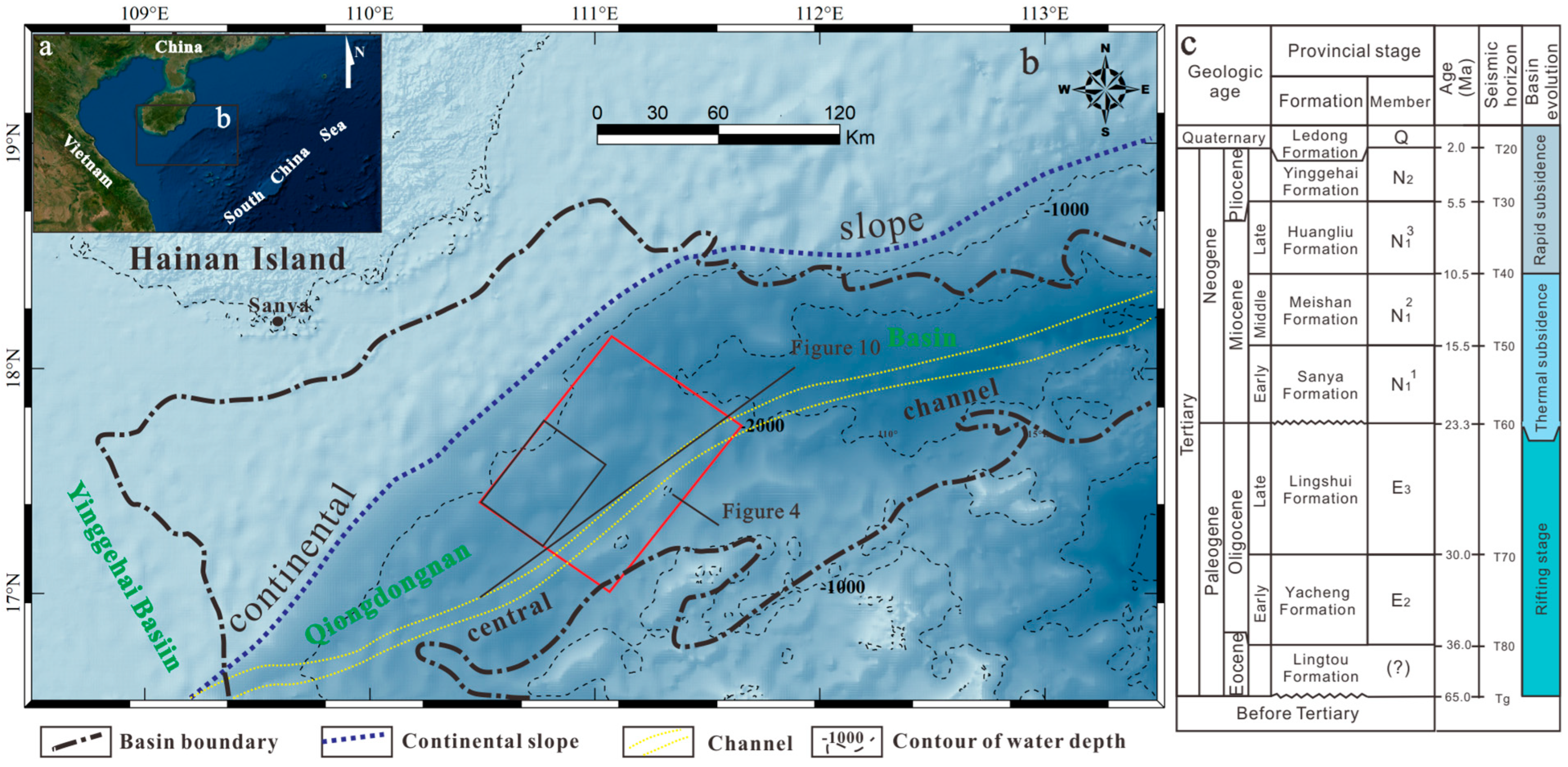

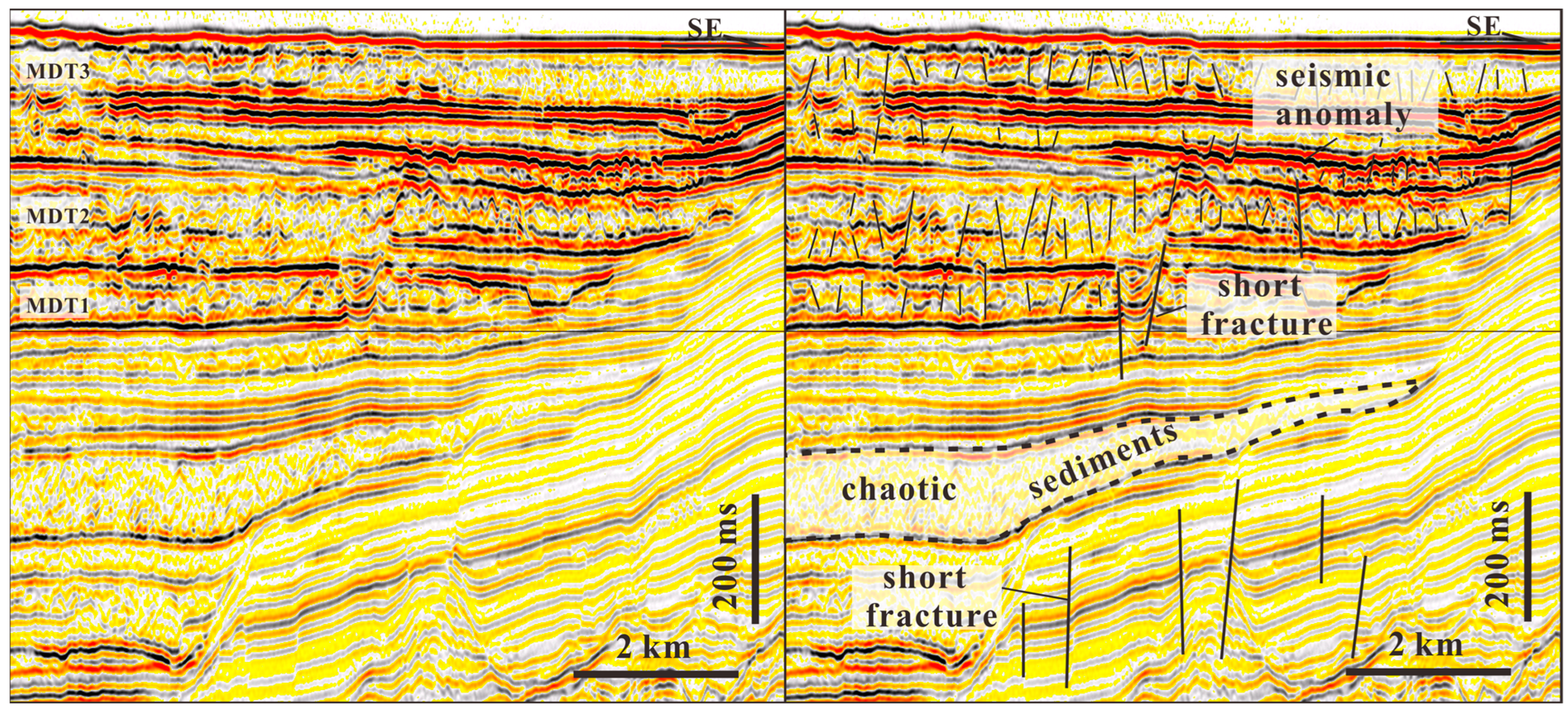
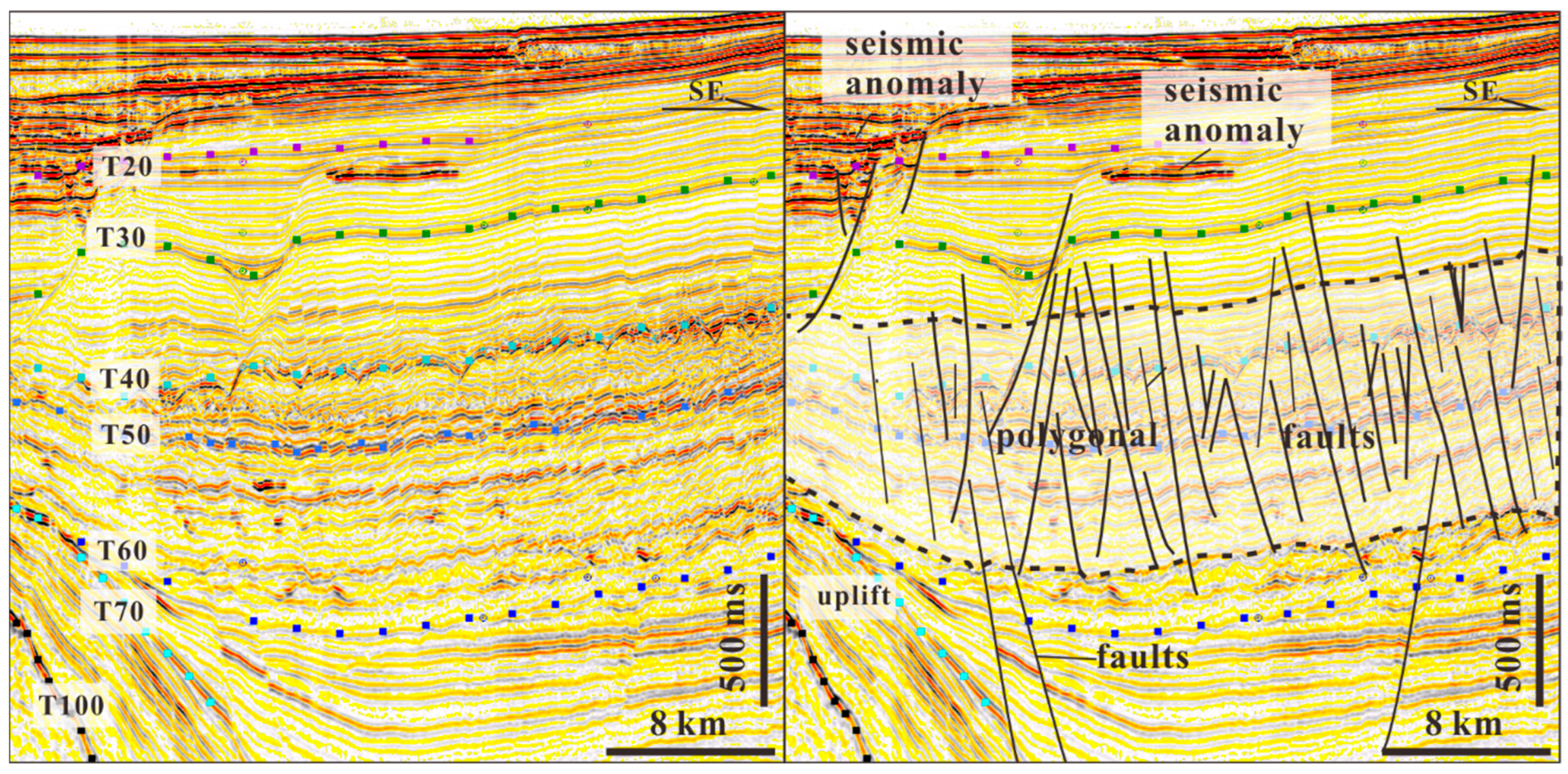
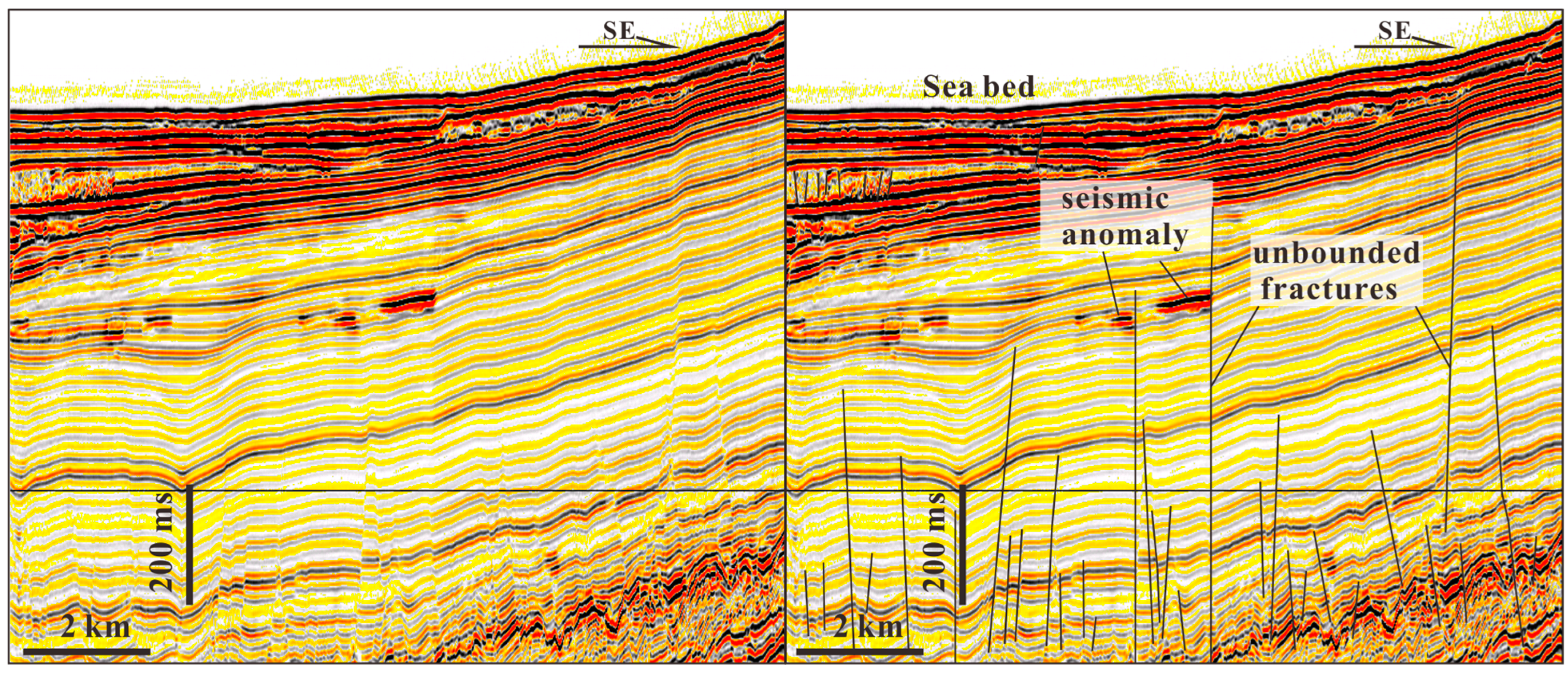

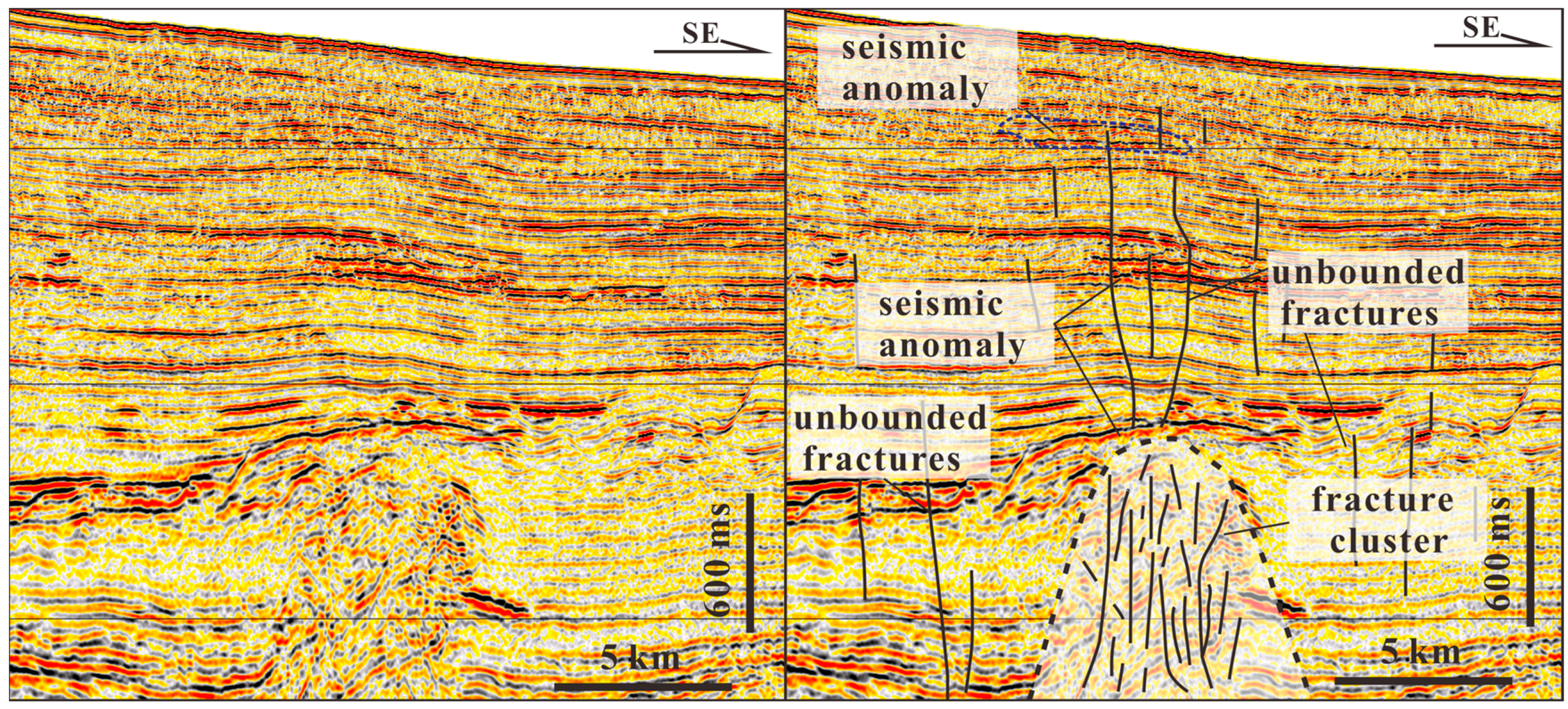
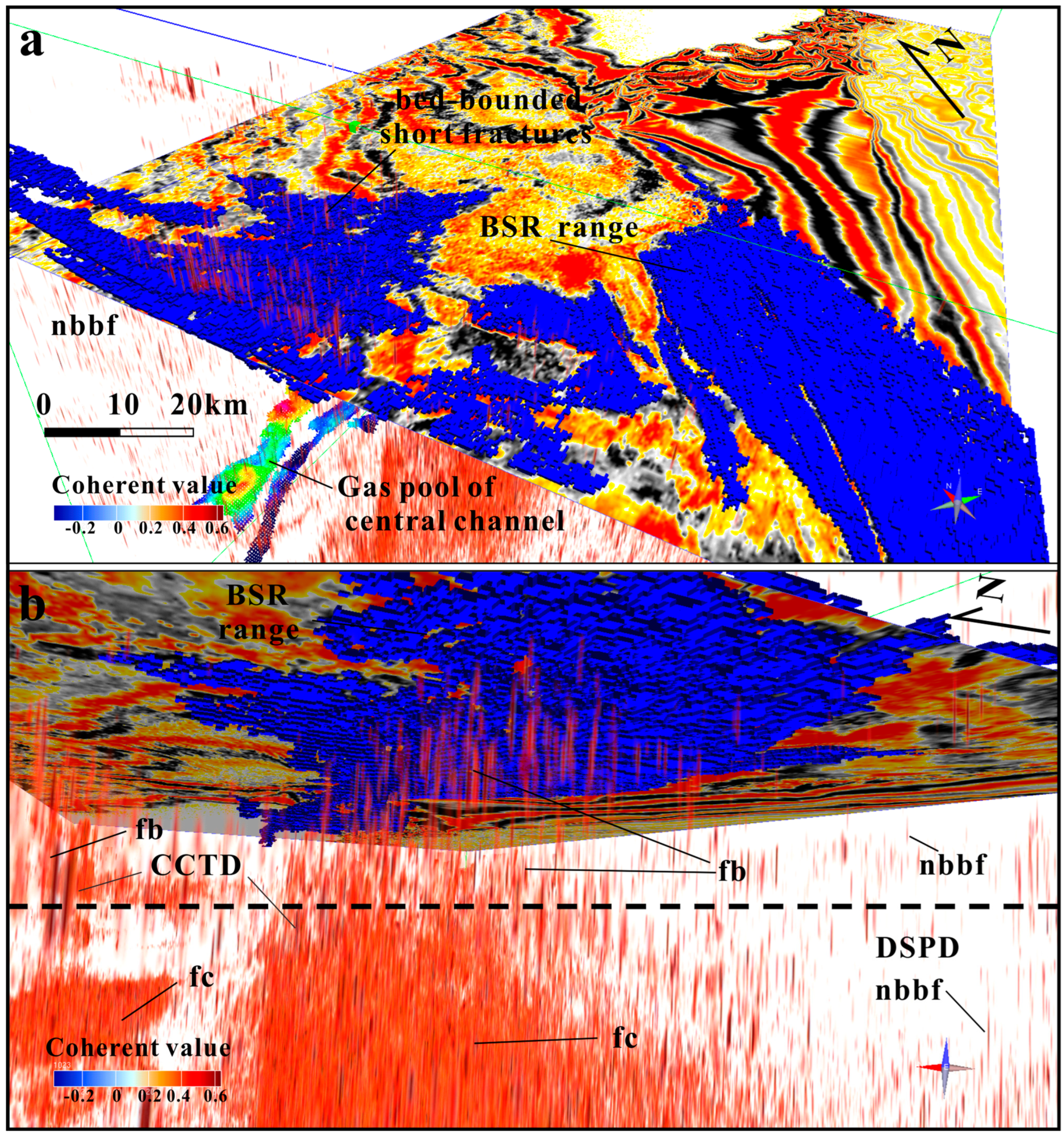
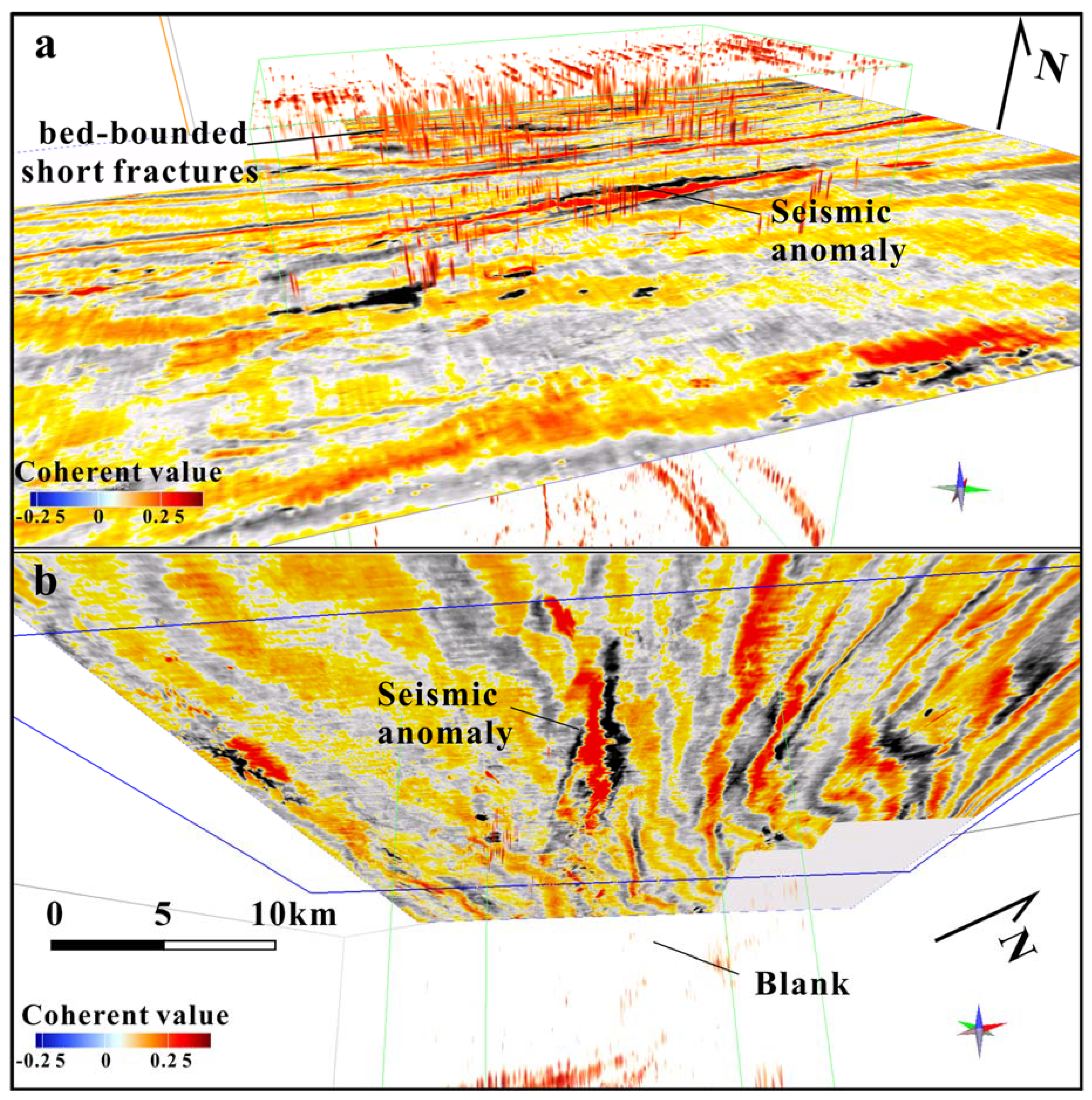

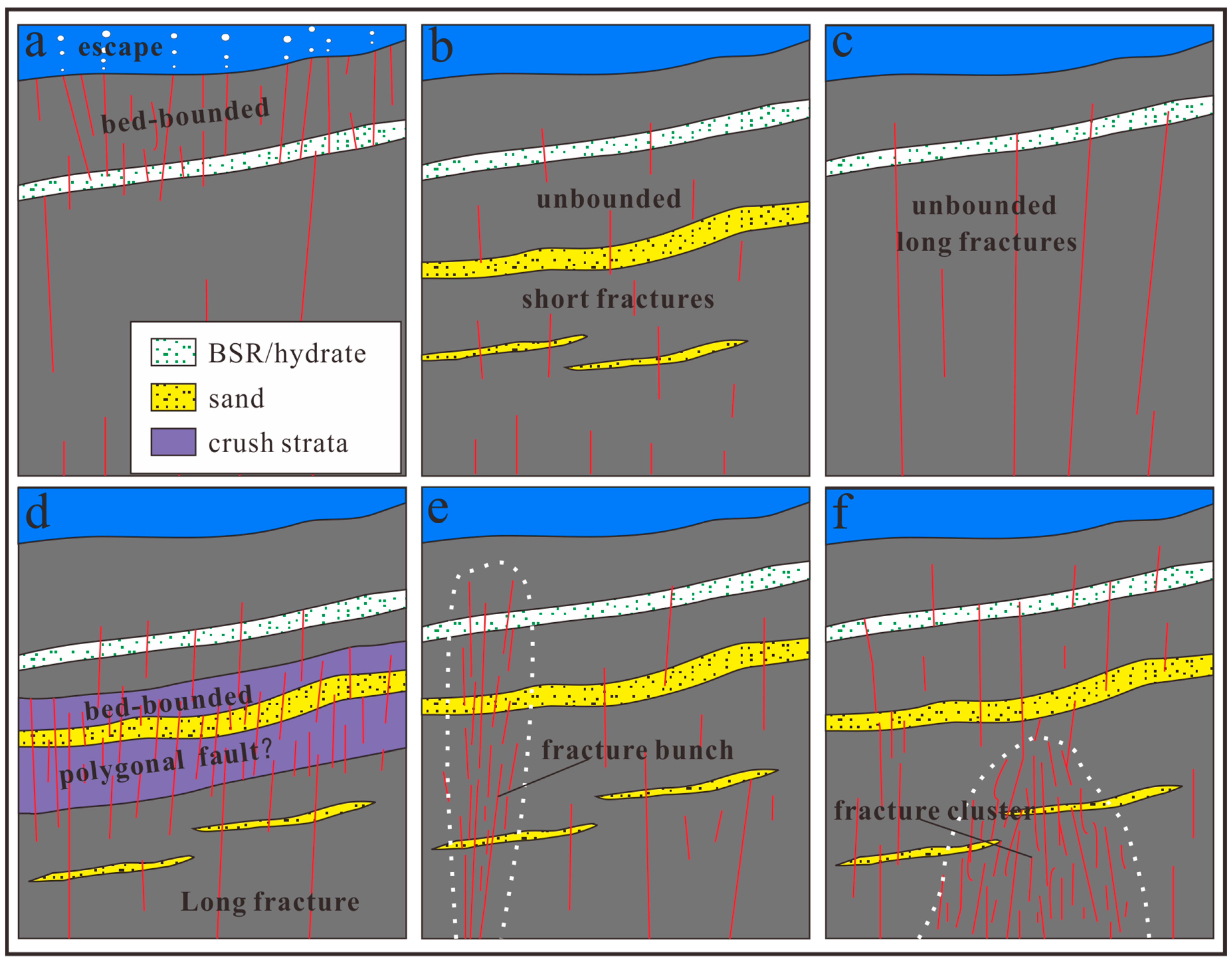
| Seismic Data | Parameters | Well Data | Parameters |
|---|---|---|---|
| Seismic | 3D | Name | GMGS5-W9-2018 |
| Acquisition time | 2013 | Water depth | 1722 m |
| Resolution above the Huangliu formation | 30–35 Hz | Bottom depth | 189 m from the seafloor |
| Acquisition track Spacing | 12.5 m | Log type | LWD |
| Vertical sampling rate | 1 ms | Log depth | 97 m from sea floor |
| Coherent volume | Extracted in 3 × 3 steps | Sample Lithology | Grey clay |
| Hydrates | Filled in fractures |
Disclaimer/Publisher’s Note: The statements, opinions and data contained in all publications are solely those of the individual author(s) and contributor(s) and not of MDPI and/or the editor(s). MDPI and/or the editor(s) disclaim responsibility for any injury to people or property resulting from any ideas, methods, instructions or products referred to in the content. |
© 2023 by the authors. Licensee MDPI, Basel, Switzerland. This article is an open access article distributed under the terms and conditions of the Creative Commons Attribution (CC BY) license (https://creativecommons.org/licenses/by/4.0/).
Share and Cite
Yu, J.; Song, R.; Chao, C. Distribution Patterns and Genesis of Geological Fractures/Microfaults in the Qiongdongnan Basin, North of the South China Sea. J. Mar. Sci. Eng. 2024, 12, 37. https://doi.org/10.3390/jmse12010037
Yu J, Song R, Chao C. Distribution Patterns and Genesis of Geological Fractures/Microfaults in the Qiongdongnan Basin, North of the South China Sea. Journal of Marine Science and Engineering. 2024; 12(1):37. https://doi.org/10.3390/jmse12010037
Chicago/Turabian StyleYu, Junfeng, Ruiyou Song, and Caixia Chao. 2024. "Distribution Patterns and Genesis of Geological Fractures/Microfaults in the Qiongdongnan Basin, North of the South China Sea" Journal of Marine Science and Engineering 12, no. 1: 37. https://doi.org/10.3390/jmse12010037
APA StyleYu, J., Song, R., & Chao, C. (2024). Distribution Patterns and Genesis of Geological Fractures/Microfaults in the Qiongdongnan Basin, North of the South China Sea. Journal of Marine Science and Engineering, 12(1), 37. https://doi.org/10.3390/jmse12010037






